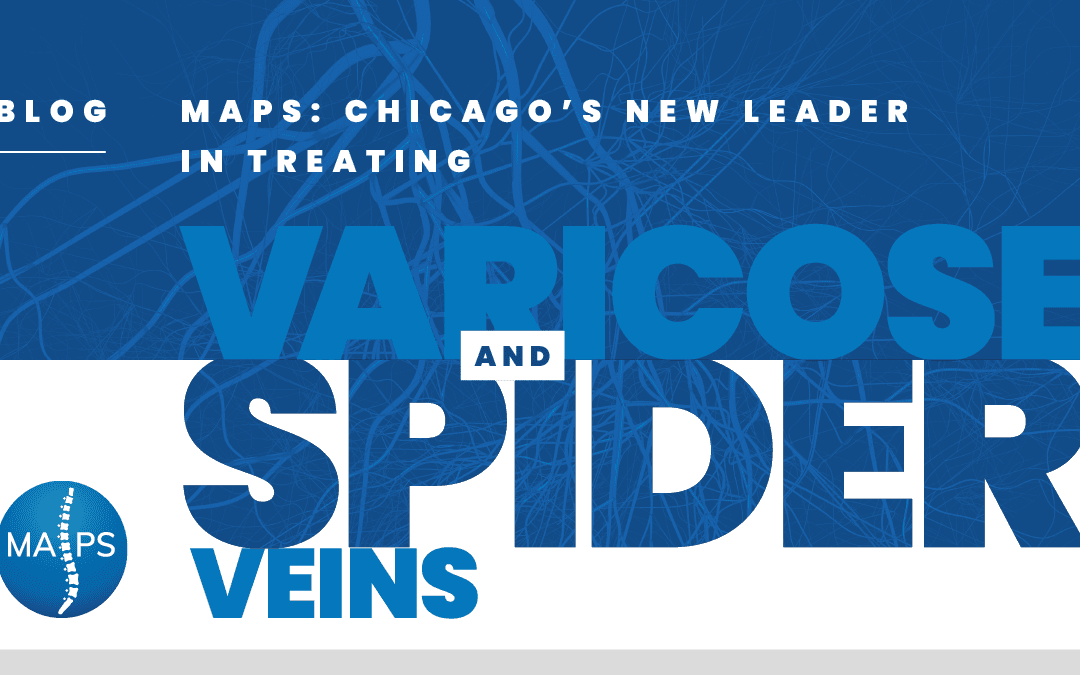Blueish, elevated, clearly visible veins behind the knees, thighs, or along the legs. Many children first learn about varicose and spider veins by spotting them on their parents or grandparent, and attribute it to age. But varicose and spider veins have nothing to do with age—and may be a lot more common than you think.
According to a medical study from 2014, nearly a quarter of adults live with varicose veins. If you factor in other vein conditions, such as spider veins, that percentage jumps up to 85%.
But what are the differences between the two, and what types of risks do they bring? MAPS is Chicagoland’s new leader in treating varicose and spider veins with minimally-invasive procedures, providing sound medical treatments for patients with all vein conditions. Here we cover the differences between these conditions with an emphasis on healthy, long term solutions.
Varicose Veins Explained
The Mayo Clinic sums up varicose veins as twisted, enlarged veins that are close to the skin’s surface. They typically occur on the legs because of the pressure we exert when walking.
However, sitting for long periods of time (which are part of a sedentary lifestyle) can cause blood to pool and accumulate in these areas as well, contributing to developing varicose veins.
Spider Veins Explained
Spider veins are smaller and more superficial than varicose veins, and can be blue, purple, or red. They are typically not painful and may be resolved through aesthetic treatments. Spider veins indicate that the valves of the veins are weakened and damaged, and may cause pooling and discoloration visibly under the skin.
However, just like varicose veins, spider veins should be reviewed by a medical professional to rule out any underlying medical conditions.
Are Spider Veins and Varicose Veins Dangerous?
While many patients with varicose veins may lead active, healthy lives, there are a number of lifestyle-related causes that can contribute to serious health conditions down the line.
This includes being obese or overweight, smoking (which reduces the efficiency of our blood vessels to transport nutrients), and as we just mentioned—leading a sedentary lifestyle.
The two most common dangers are inflammation and swelling of the veins, and more seriously, DVT (Deep Vein Thrombosis). This is when a blood clot develops and can be life-threatening in the event that it breaks off and moves into another part of the body, such as the lungs.
How to Treat Spider Veins and Varicose Veins
There are several methods to treat these conditions, and it depends on the cause and the severity of the case. Sometimes surgery is necessary, but it isn’t the only solution.
At MAPS’ Vein Care treatment center in Chicago, we start by diagnosing the patient using ultrasound technology to get a full picture of the veins without making an incision.
Depending on the root cause of our patient’s vein disease, we focus on minimally-invasive treatments that allow our patients to get back on their feet that very same day:
Sclerotherapy Vein Treatment
This option can be ideal for smaller spider and varicose veins. It works by administering a solution directly into the veins that causes them to thicken and seal shut, stopping the flow of blood. Typically, the vein will fade away within a few weeks.
Ablation for Spider Veins
This is a cutting-edge technique that uses frequencies to heat, shrink, and close the damaged veins.
Varithena Vein Treatment
This treatment also uses injection to close damaged veins, using a special microfoam without the need for incisions or stitches. More than 96% of patients reported no pain or discomfort, and the procedure is done within an hour.
Live Your Life Varicose and Spider-Vein Free
While varicose veins are sometimes considered a cosmetic issue, they’re oftentimes a result of an underlying issue that needs to be diagnosed and treated by a medical professional.
You deserve to live your best life: pain-free, and spider vein-free. Our procedures are covered by most insurances and our doctors are ready to help you get the results you want.
To schedule your free consultation, contact Chicago’s leading vein doctors today.


